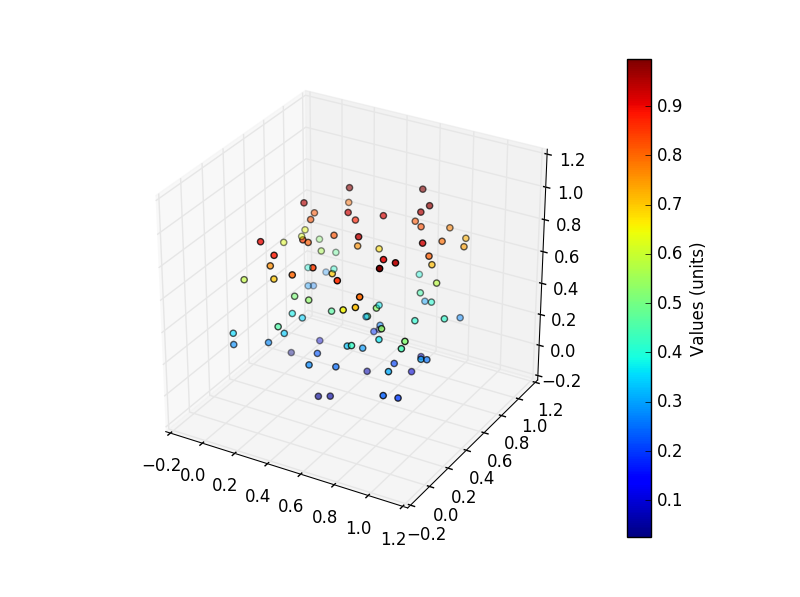
Step #1: Import pandas, numpy and matplotlib! Note: By the way, I prefer the matplotlib solution because I find it a bit more transparent. The two solutions are fairly similar, the whole process is ~90% the same… The only difference is in the last few lines of code. Scatter plot in pandas and matplotlibĪs I mentioned before, I’ll show you two ways to create your scatter plot.
2d scatter plot matplotlib how to#
It’s time to see how to create one in Python! Okay, I hope I set your expectations about scatter plots high enough. But in the remaining 1%, you might find gold! Well, in 99% of cases it will turn out to be either a triviality, or a coincidence. There are always exceptions and outliers!)īut it’s also possible that you’ll get a negative correlation:Īnd in real-life data science projects, you’ll see no correlation often, too:Īnyway: if you see a sign of positive or negative correlation between two variables in a data science project, that’s a good indicator that you found something interesting - something that’s worth digging deeper into. (Of course, this is a generalization of the data set. The greater is the height value, the greater is the expected weight value, too.

This above is called a positive correlation.
2d scatter plot matplotlib code#
Note: this article is not about regression machine learning models, but if you want to get started with that, go here: Linear Regression in Python using numpy + polyfit (with code base) regression line) to this data set and try to describe this relationship with a mathematical formula. Looking at the chart above, you can immediately tell that there’s a strong correlation between weight and height, right? As we discussed in my linear regression article, you can even fit a trend line (a.k.a. Scatter plots play an important role in data science – especially in building/prototyping machine learning models.

So, for instance, this person’s (highlighted with red) weight and height is 66.5 kg and 169 cm. and each blue dot represents a person in this dataset.This particular scatter plot shows the relationship between the height and weight of people from a random sample. At least, the easiest (and most common) example of it. You’ll get something like this:īoom! This is a scatter plot. the x-axis shows the value of the second variableįollowing this concept, you display each and every datapoint in your dataset.the y-axis shows the value of the first variable,.Scatter plots are used to visualize the relationship between two (or sometimes three) variables in a data set. What is a scatter plot? And what is it good for? You can also find the whole code base for this article (in Jupyter Notebook format) here: Scatter plot in Python. This is a hands-on tutorial, so it’s best if you do the coding part with me! Pandas Tutorial 4 (Plotting in pandas: Bar Chart, Line Chart, Histogram).Pandas Tutorial 2 (Aggregation and grouping).Python libraries and packages for Data Scientists.Note: If you don’t know anything about pandas (or Python), you might want to start here: Let’s see them - and as usual: I’ll guide you through step by step.

one will be using pandas (more precisely: ()).Both solutions will be equally useful and quick: In this pandas tutorial, I’ll show you two simple methods to plot one. How can I re-use the above data set to generate a heatmap of the same data (i.e.Scatter plots are frequently used in data science and machine learning projects. How do I combine the logic above to render a data set like so: ,Īs something like this, via matplotlib/ pyplot (discrete-domain, discrete-range, continuous-valued): I would like to plot this data, using only Python, ( only at the integral x-y intersections), like in the plot below, but using my own x-y scatterplot data, rather than plotting a 2D line/function.Īdditionally, I would like to combine the "specify dot size" logic from another SO question, which allows me to specify the dot size on a "per-sample/value" basis, i.e.: The x-y coordinates represent the x-y distribution of data points, and the value at each x-y coordinate is the mass/intensity measured at that data point. The data represents a circle-like "mass distribution" plot in 2D space. I have a 2D set of "raw" data points, in the form of an array, i.e.: ,


 0 kommentar(er)
0 kommentar(er)
